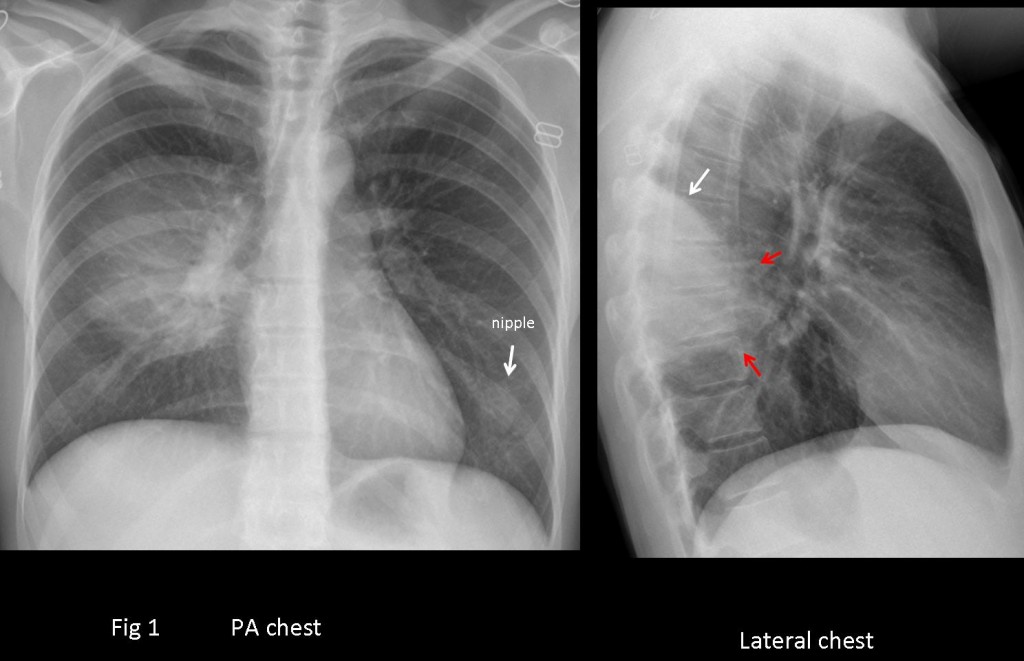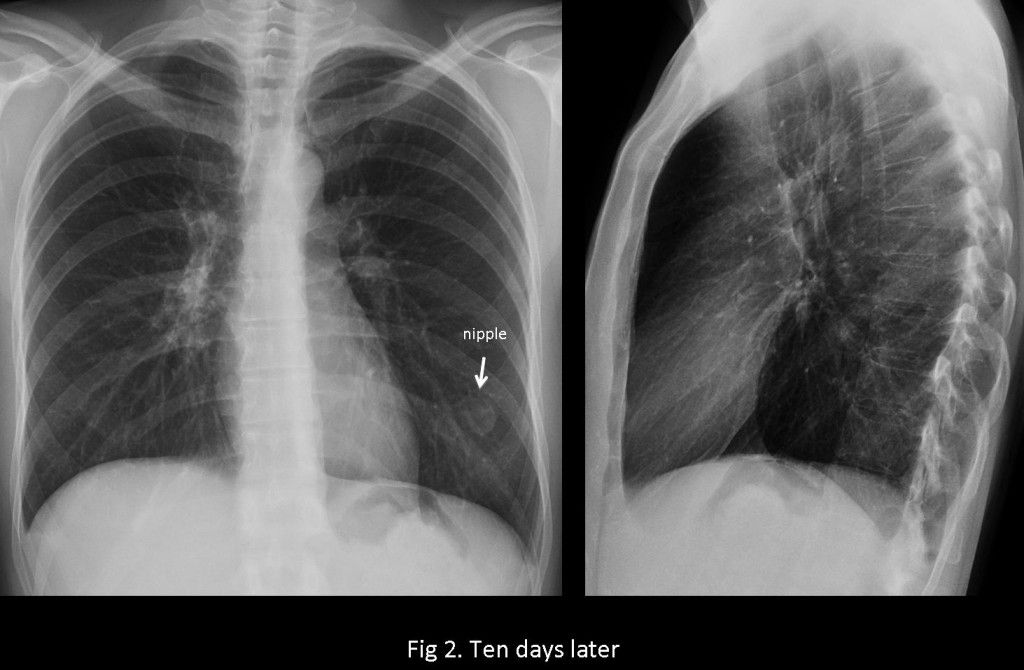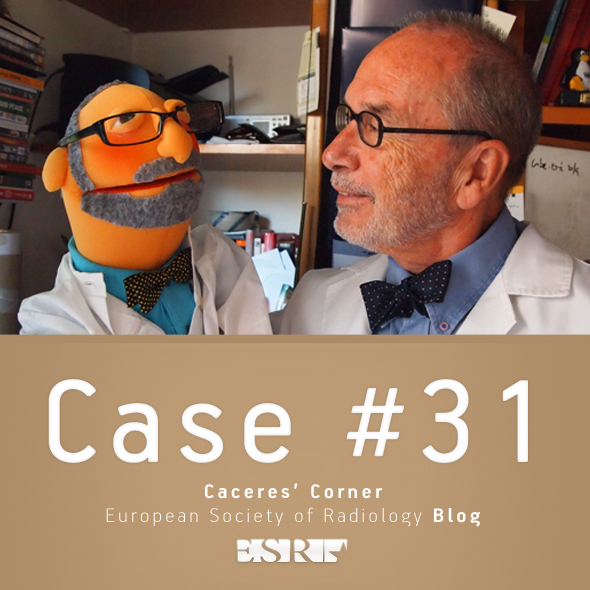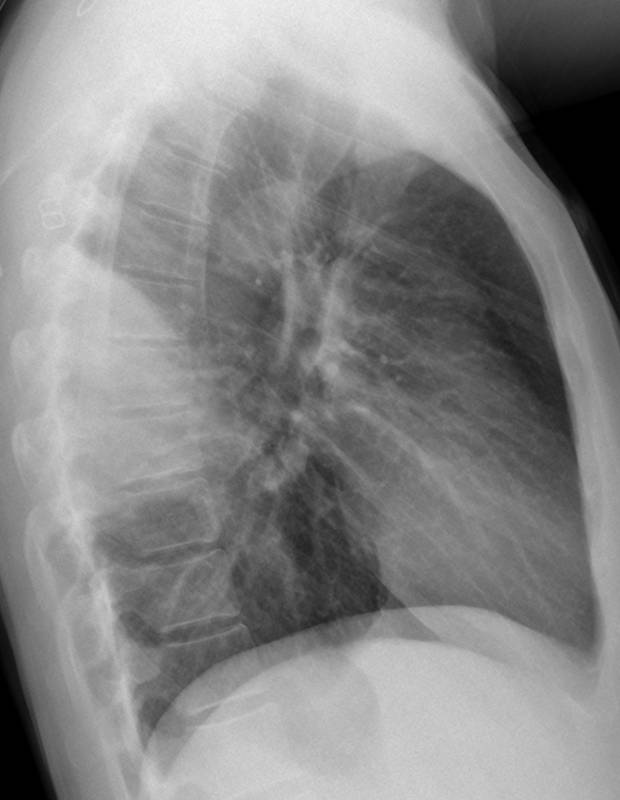Muppet is becoming soft and wants to show easy cases. The following case is a 44-year-old woman with a cough, low-grade fever, and back pain.
1. Lung mass
2. Loculated pleural fluid
3. Chest wall mass
4. None of the above
Before giving the answer, it is important to understand the semiology of extrapulmonary lesions: they are well defined (because of the pleural layer which surrounds them), and have obtuse angles at the corners (to see an example of extrapulmonary lesion go to
case 1 in Dr. Pepe’s Diploma Casebook).
In case 31, the lateral view shows good definition of the lesion in the superior portion when it abuts the major fissure (arrow), whereas two thirds of the contour is ill-defined (red arrows).

Fig. 1
The lack of well-defined borders excludes an extrapulmonary lesion (answer 2 and 3 are out) and places the lesion within the lung. Although a pulmonary mass cannot be ruled out, the symptoms point to a round pneumonia. Correct management is to treat the patient and repeat the examination. It is unnecessary to do a CT. In this case, chest radiographs after ten days show complete resolution of the pneumonia (fig 2). Final diagnosis: round pneumonia in superior segment of right lower lobe.

Fig.
Teaching point: when discovering a lesion in a chest radiograph, our first consideration should be to define where such a lesion is located: mediastinum, lung, or pleura/chest wall. Placing the lesion in the wrong compartment will lead to an erroneous diagnosis.







1
As we can see, this large homogenic shadow is situated in the superior segment of RLL, it has round shape on the PA chest and well-defined circuit on the lateral chest radiogram. Surrounding lung tissue looks calm. The bronchi walls look a bit thick. On the lateral chest I can see a thick intermediate stem line. I vote for a lung mass.
Consolidation of RLL and left sided oval lesion, the latter possibly a posterior chest wall lesion (the vertebral arcus th12 appears denser than the others).
It Looks like there is more than one pathology, therefore i choose 4.
Oval lesion on the left is the nipple. The opacity in T12 is artefactual.
non of the above
Any suggestions?
this what we call seen through the lung shadow it could be hydatid cyst , NF
Semiology is against hydatid cyst, which should be well defined in both projections
“round”pneumonia
Chest wall mass
a relatively homogenous, well conturated opacity, in the right hemithorax with :
-absence of surrounding lung lesion and the presence of sharply limited contur with the lung may exclude lung disease, the right hilar structures are will vizibile.
-absence of ribs lesion may exclude chest wall disease.
-all the mediastinal lines is vizibile and not affected
so i don think it is a mediastinal lesion.
-having obtuze angle (especialy the superior one)with the posterior chest wall, vizibil in the lateral veiw and asociated withh a little pleural thickening may be compatibil with loculated pleural fluid which asociated with another smaller similar lesion inferior to the 1st big lesion vizibile in the lateral veiw.
so i vote with loculated pleural fluid.
Very unusual to have loculated fluid when the costophrenic angle is not blunted
On these x-rays I can see located homogenous consolidation of the right middle lung with triangle form that lies on wide basis to pleura costalis.I think the answer is none of the above.I think Pleuropneumonia dextra.
L’illustre collega scherza :il caso NON è facile.Ma voglio Voglio dimostrare che sebbene il mio Bari_calcio non giocherà MAI in coppa dei campioni con il Real Madrid, sul piano del gioco( scientifico) Bari puo’ competere con il Real.La risposta è la 4:neuro-fibroma plessiforme in Neuro-fibromatosi tipo 1.L’opacità non è polmonare(per varie ragioni);essa è tenuemente opaca;si associa ad allargamento dei forami di coniugazione intervertebrale( in LL);vi è sclerosi di un peduncolo vertebrale in una vertebra sottostante.DD con meningocele ad estrinsecazione anteriore.
Pleural tumors typically appear as well-defined soft-tissue masses, with angles obtuse to the chest wall.
The Obtuse angles with the chest wall are seen on the lateral x ray.
The front view shows an upward displacement of the minor fissure, because is being pushed by the tumor .
Conclusion: for me it is a pleural tumor and considering the clinical findings I think it could be a localizad fibrous tumor of the pleura
neurogenic tumor in the post mediastinum
maybe S6 pneumonia, its not look very bad.
It looks extrapulmonary finding, may be loculated fluid or a pleural mass.I dont think there is mediastinal compromise.
In the lateral view I see shadow-homogenous ,well conturated, lies on wide basis and has convex curved boundaries ,disigning inside the lung – it seems more likely it is pleural genesis.
I think it is a pleural tumor.
In the front view the image does not seem so homogeneous, form me it is difficult to distinguish if the heterogeneity of the image is by the lesion itself or by overlapping structures.
If the lesion is not homogeneous I think there is a air bronchogram, therefore my answer changes to round pneumonia. Although this is not mandatory because the literature says: only 17% of patients with round pneumonia had air bronchograms (AJR 1998; 170: 723)
This is one of the reasons why they are called round pneumonias. What would you do to prove your diagnosis?
And this diagnosis support the clinical symptoms
I would ask for previous studies to compare. The articule mentions that a 2- to 3-cm mass that has appeared in the last 2-6 weeks is more likely infectious than neoplastic.
If there are no previous studies I would start antibiotics treatment and do a follow up with chest x-ray to exclude underlying mass
Good!
answer is no. 4 i think it is a posterior mediastinal mass….. for furthur assessment by CT
Posterior mediastium mass
must check chanel bags price for gift